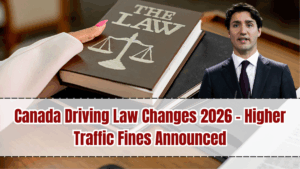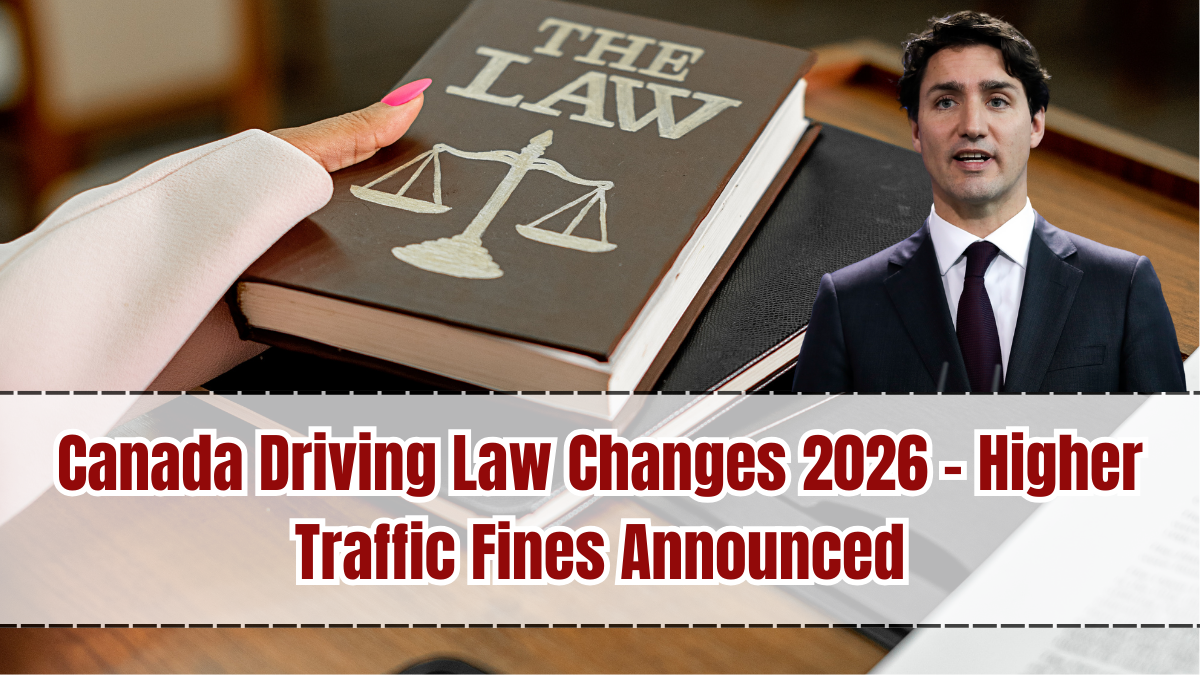The Canadian government has confirmed a new wave of driving law changes in 2026, with a major focus on higher traffic fines, stricter enforcement, and expanded safety measures. Following the 2025 reforms, this update strengthens the country’s commitment to road safety by introducing tougher penalties for reckless, distracted, and impaired driving.
For motorists, the Canada Driving Law 2026 update means steeper financial consequences for violations, greater risks of license suspensions, and broader use of technology in monitoring compliance.

Why Canada Is Raising Traffic Fines in 2026
The increase in fines and enforcement comes after continued concerns about road safety:
-
High Accident Fatalities: Traffic deaths remain among the top causes of preventable deaths in Canada.
-
Distracted Driving Epidemic: Mobile phone use behind the wheel continues to rise.
-
Drunk & Drug-Impaired Driving: Cannabis legalization and alcohol-related crashes remain major concerns.
-
Rising Enforcement Costs: Police and provincial agencies need stronger deterrents to curb violations.
-
Global Benchmarking: Canada is aligning its penalties with international standards seen in the EU and Australia.
Key Driving Law Changes – 2026 Update
-
Distracted Driving Penalties
-
Fine increased from $800 to $1,200 CAD.
-
Demerit points raised to 8 points per offense.
-
Repeat offenders may face 180-day license suspensions.
-
-
Excessive Speeding Fines
-
Driving 40 km/h over the limit: Fine increased to $3,000 CAD.
-
Driving 60 km/h over the limit: Possible jail term of up to 30 days.
-
Double fines in school zones and residential areas remain in effect.
-
-
Impaired Driving – Alcohol & Cannabis
-
Minimum fine increased to $3,500 CAD for first-time offenders.
-
Automatic 2-year license suspension on first conviction.
-
Repeat offenders may lose licenses permanently.
-
-
Seatbelt and Child Safety Law Expansion
-
Not wearing a seatbelt: Fine increased to $800 CAD.
-
Child restraint violations: $1,200 CAD per offense.
-
Police given greater authority to conduct roadside checks.
-
-
Parking and Obstruction Rules
-
Illegal parking fines increased by 40% in large cities.
-
Blocking emergency lanes: Fine increased to $2,000 CAD.
-
Repeat violators risk vehicle impoundment.
-
-
Demerit Points & License System
-
Novice drivers (G1, G2, learner permits): Suspension at 4 points (down from 6).
-
Full license holders: Suspension at 10 points (down from 12).
-
Suspended drivers must attend mandatory rehabilitation programs before reinstatement.
-
Role of Technology in Enforcement – 2026 Expansion
The 2026 update increases reliance on smart enforcement:
-
AI Cameras Nationwide: Expanded installation across highways and urban areas.
-
Automatic Number Plate Recognition (ANPR): Detects uninsured, unregistered, or suspended vehicles.
-
Digital Penalty Notices: Tickets issued via online government portals.
-
Insurance Data Sharing: Violations automatically shared with insurers, raising premiums for offenders.
Impact on Motorists
These changes will have direct consequences for drivers:
-
Financial Impact: Violations will cost significantly more, discouraging repeat offenses.
-
License Risks: Stricter demerit rules mean suspensions will occur faster.
-
Insurance Hikes: Convictions and tickets will push premiums up by 20–40%.
-
Professional Drivers: Truck, taxi, and rideshare operators face stricter compliance.
-
Public Transport Push: Higher penalties may encourage more Canadians to use public transit.
Benefits of the 2026 Law Changes
Despite the tough stance, the updates bring clear benefits:
-
Improved Road Safety: Expected drop in accidents and fatalities.
-
Consistency Across Provinces: Creates a more uniform traffic law system.
-
Fair Enforcement: AI and digital systems reduce human error and corruption.
-
Economic Savings: Fewer accidents mean reduced healthcare and insurance costs.
Concerns from the Public
Some citizens and advocacy groups have voiced concerns:
-
High Fines for Low-Income Drivers: Critics argue penalties should be income-based.
-
Rural Challenges: Limited access to public transport may make stricter laws harder for rural Canadians.
-
AI Enforcement Issues: Worries about wrongful fines due to system errors.
-
License Suspension Rules: Some fear novice drivers will be punished too harshly for minor mistakes.
How Drivers Can Prepare for 2026
-
Stay Informed: Monitor government updates before the laws come into effect.
-
Drive Defensively: Avoid speeding, distracted, and impaired driving at all costs.
-
Check Demerit Points: Track license status to prevent surprise suspensions.
-
Budget for Insurance: Expect premium increases if fines are received.
-
Plan for Alternatives: Use public transport where available to cut risks.
Conclusion
The Canada Driving Law Changes 2026 represent a major shift in the country’s traffic enforcement strategy. With higher fines, stricter demerit thresholds, and expanded use of AI technology, the government aims to deter reckless behavior and protect all road users.
While these changes may feel strict, they reflect Canada’s long-term goal of reducing traffic deaths and building safer roads. For drivers, the message is clear: obey the rules, drive responsibly, and stay compliant to avoid heavy penalties.
FAQs
What is the new distracted driving fine in 2026?
The fine increases to $1,200 CAD, with 8 demerit points per violation.
How much is the penalty for excessive speeding in 2026?
Fines can reach $3,000 CAD, with possible jail terms for extreme violations.
What happens if you are caught drunk or drug-impaired driving?
First-time offenders face a $3,500 fine, 2-year suspension, and repeat offenders risk permanent license loss.
How many demerit points will cause license suspension?
-
Novice drivers: 4 points.
-
Full license holders: 10 points.
Will AI cameras issue fines automatically in 2026?
Yes, AI-powered cameras and ANPR systems will monitor roads and issue digital penalty notices in real time.
Click here to know more.




